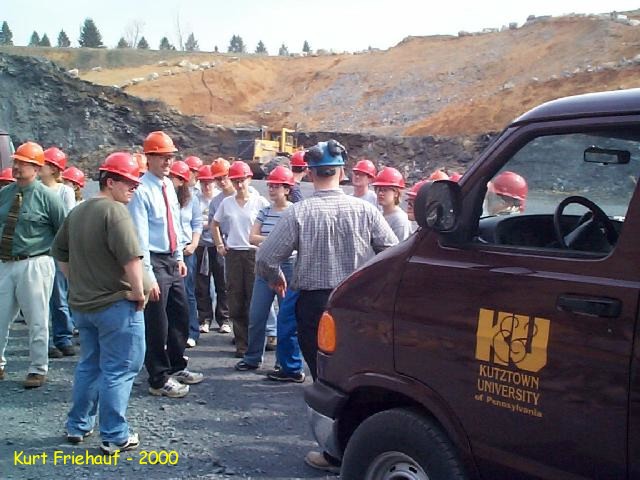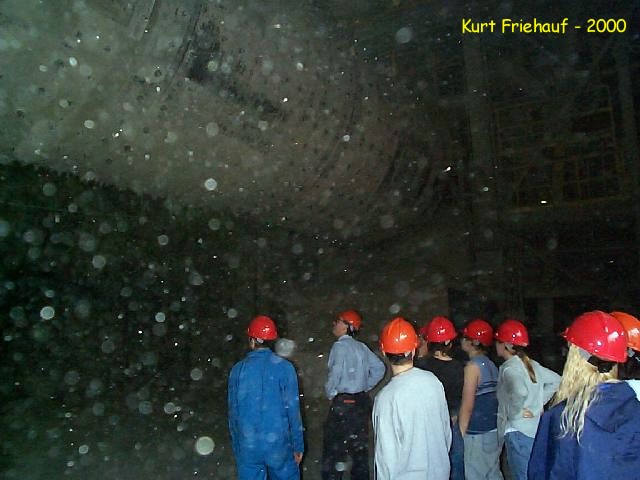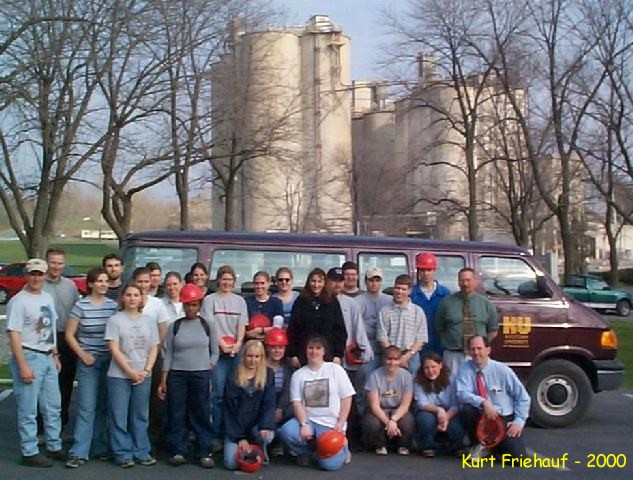
GEL100
– Tour of the Allentown Cement Plant
Kurt
C. Friehauf
One of the most fascinating fieldtrips I’ve run with the intro-level geology students is to the Allentown Cement Plant. Few people know it, but the Lehigh Valley area (i.e., right around Kutztown University) was the first place in the United States where Portland cement was manufactured. The reason for this lies in the geology of the area.

Portland Cement is the most common type of cement used today
due to its
vastly greater strength compared to other cements.
The ingredients are essentially the same as Natural Cement (lime,
silica, alumina, and iron oxides [1]),
but the calcining process is done at a much higher temperature [2]. The precise
proportion of ingredients is
important. In most cases, this requires
mixing of several rocks together, although the limestone in select
regions
naturally contains the appropriate elements in the appropriate
proportions.
The
powdered product is primarily a mixture of tricalcium silicate (3CaO
· SiO2),
tricalcium aluminate (3CaO · Al2O3), and
dicalcium
silicate (2CaO · SiO2), in varying proportions, along
with lesser
amounts of magnesium and iron compounds and gypsum. Gypsum is often added after
calcining to slow the hardening
process. Dolomite (CaMg(CO3)2)
and alkalis are harmful impurities.
The compounds in active cement are unstable together. When water is added, they rearrange their structure and interact chemically to form interlocking crystals of calcium-aluminum-silicates that bind together the particles of sand or stone.
Although Portland Cement was invented in England in 1824, the first Portland Cement produced in the United States was in Lehigh Valley in 1875. Because the Middle Ordovician Jacksonburg argillaceous limestone of eastern Pennsylvania naturally consists of the correct proportions of lime, silica, and alumina, and the abundant coal in the region is a cheap source of heat for the kilns, eastern Pennsylvania was a natural choice for the manufacture of Portland Cement.
The coincidence of the natural supply of the raw materials for cement with a ready supply of coal needed to calcine it into a usable form, all in proximity to some of the U.S.’s largest population centers was crucial to our ability to grow during the industrial revolution. To appreciate this, some day while you’re walking around, take a moment out to notice the many things around made of concrete [3]. Concrete is strong and can easily be formed into almost any shape. What would we make things like buildings and sidewalks out of if not concrete? (Remember – in the days before concrete, many buildings were made of wood, which led to great fires that wiped out large sections of many cities, such as the Great Chicago Fire).
Our fieldtrip
took us first into
the quarry where they dug up the raw materials for the cement. They pretty much just blast the rock and
load it into the back of a small haul truck with a small loader.

After touring the quarry, they
walked us along the giant rotary kiln (seen to the left of us as we
descended
the stairs). This is a giant
cylindrical pipe about 15 feet or so in diameter that slowly turns. The kiln is on a gentle incline, so that raw
materials dropped in one side slowly mix and make their way down to the
lower
end. Pulverized coal is blown up into
the kiln from the lower end as fuel to heat the mixture and calcine the
limestone. Old, discarded steel-belted
radial tires are added as a second source of fuel and as a
source of
iron, which is crucial to the mix.

The kiln gets incredibly
hot. They let us view the inside of the
kiln by peeping through a small window using a special face shield. Inside, we could see the churning mass of
incandescent, partially molten rock and burning coal.
It is truly a remarkable sight!!

After viewing the
kiln, they took
us to the control room where we saw that the process is really quite
high-tech. They monitor the temperature
of the mix, composition of exiting gasses, etc. constantly. They also use an X-ray Fluorescence
Spectrometer to monitor the bulk composition of the clinker coming out
because
that greatly affects the strength of the cement. They
have a petrographic microscope, too, which they use to
analyze the shapes and proportions of the crystals of tricalcium
silicate, tricalcium aluminate, and dicalcium silicate when the cement
is cured
– also strong factors in determining the strength of the cement.

Finally, they
showed us the ball
mills where they grind the clinker into a powder. Ball
mills are big, spinning cylinders that contain cannon balls
made of hard steel. When they put
clinker in the cylinders, the spinning tube causes the balls to bounce
around
and break up the clinker into a powder.
The powder is mixed with gypsum (which slows the hardening
process and
allows for better control during pouring at the construction site) and
put into
bags for sale.

Here is our final
group photo, with
the storage towers in the background.
That’s doctor Simpson standing behind me – he’s one of the other
geologists in our department who couldn’t pass up the opportunity to
join us on
what was a really wonderful trip. The
people at Allentown Cement were really wonderful to us and are a credit
to the
community.

[1] Lime is a powder made of calcium oxide (CaO) produced by baking the carbonate out of calcite in limestone. Silica is a generic term for SiO2 - quartz. Alumina is aluminum oxide Al2O3, common in clay and many silicate minerals.
[2] Calcine means to heat a rock up to a very high temperature - hot enough to burn off any water and carbon, but not hot enough to actually melt the rock. We produce lime by calcining limestone.
CaCO3 + heat = CaO + CO2(g)
Calcite
Lime
[3] Concrete is the name we use to describe the aggregate-cement mixture. Aggregate is the sand and gravel, added to cement to increase bulk and strength.